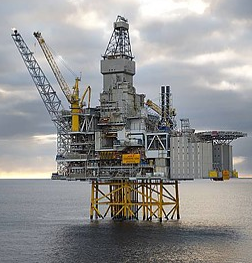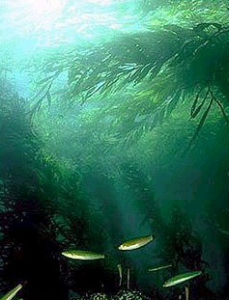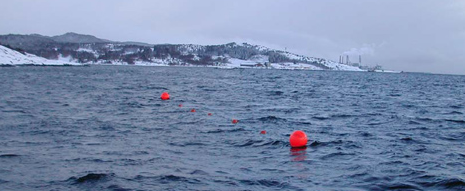

In the race to develop greener energy, no self-respecting global oil company wants to be left behind. They're already bulking up on natural gas. Recently, French oil major Total has invested in solar cell maker SunPower; meanwhile Shell, Exxon, and Chevron have invested hundreds of millions in biofuel technology, and BP has added biofuels to wind.
Statoil, the biggest offshore energy producer in the world--bigger than BP or ExxonMobil--is playing to its strength and developing a novel seaweed-to-ethanol process with Bio Architecture Lab (website), a small California startup that received its first serious funding from DOE's ARPA-E, and already has one ongoing research project in Chile.
Bypassing biofuel's lignin problem
Why seaweed or macroalgae? Primarily because it's buoyed by water, and it doesn't make lignin to help it stand up against gravity, like the stalks and trunks of land

plants. Lingin has been one of the greatest obstacles to creating what DOE's Steven Chu calls the "cellulosic economy."
Strong and some even call it gnarly, lignin resists easy degradation or seperation, a key obstacle in bringing biofuels made from grasses, corn stalks, or trees to market and making seaweed much easier to convert to fuels. Like land plants, the carbohydrates in seaweed can be processed several ways: burned via pyrolysis to make oil; fermented with bacteria into ethanol; or converted into methane via anaerobic digestion.
There are other pluses: seaweed is widely grown and understood throughout the world, with more than 100 years of aquaculture (which has nothing to do with Olympic synchronized swimming). Norway already has a small industry built around seaweed. An article in DiscoveryNews reports that wild kelp is harvested on a five-year rotation for production and sale of alginates, whcih are used as stabilizers and emulsifiers in foods, among other things.
Statoil's and Bio Architecture Lab's strategic alliance
As part of a strategic partnership with startup Bio Architecture Lab, Statoil will fund research and development for BAL's technology, which converts seaweed (macroalgae) into ethanol. By using macroalgae as a feedstock, BAL is able to overcome many of the issues that have hampered the widespread adoption of second generation renewable fuels. BAL will be able to produce biofuels and chemicals that:
- Dramatically reduce CO2 emissions
- Don't compete with land used for food and feed
- Don't require increased use of fertilizer or other chemicals.
Statoil will be responsible for managing the aquafarming, and the two companies working together will develop a demonstration facility in Norway. If it goes well, Statoil will then commercialize it in Norway and elsewhere in Europe.

Interview With Daniel Trunfio, CEO, Bio Architecture Lab
Read a portion of a Biofuels Digest's , Sept 2010, interview with Bio Architecture Lab's CEO Daniel Trunfio, a former 25-year veteran at Shell, that was conducted right after the deal:
BD: Why Chile?
DT: It was a combination of a high-yield native strain, and the opportunity to work with the world's leading authority on improving yields, Dr. Alejandro Bushman of the University of Los Lagos in Puerto Montt. His research has pioneered methods to grow seaweed at high densities.
BD: Why macroalgae?
DT: In Asia they have grown seaweed at commercial scale for food for 100 years. In China they grow 30-35 tons per hectare by hand cultivation. We use a brown non-edible native to Chile and are industrializing our techniques to increase the yields. But one of the special things we like is that seaweed is the fastest growing plant in the world, and it does not have lignin.
Also, it's already well studied, and requires no fertilizer inputs like corn and sugar. Plus, its good for eutrophication--it grows off nutrients in the water and cleans up the oceans when you grow it.
BD: How dense can BAL grow macroalgae?
DT: Working with Dr. Bushman we have a target of 40-50 dry tons per hectare.
BD: Doing any GMO?
DT: No, but we have a strain selection and breeding program to improve sugar concentration. In Asia seaweed yields are improving by up to five percent per year because it is still younger as a practice than corn.
BD: Tell us about your magic bug that converts seaweed to ethanol.
DT: It's the second piece of the value chain--once you have the seaweed, our 'magic microbe' is like a consolidated bioprocessor you may have read about [with companies like Mascoma or Qteros]. Our bugs access the sugars and break those up so they are fermentable, then ferment them into ethanol.
BD: That's two major pieces of the value chain--a lot for a young company?
DT: I like the opportunity --as a former VP with Shell in trading-- I am all about optionality. More options allow us to play in the entire value chain. Think of an upstream oil exploration company that brings in oil from offshore platforms and then puts it into its refineries. Our value proposition is not dissimilar, except our offshore wells are green instead of black. We bring the feedstock to shore, and if an oil company partners with us, they can take that process and scale it.
BD: What's different about the Statoil partnership?
DT: With Statoil it is a different seaweed, and we are talking to folks in Asia about another seaweed. Our goal is to be seaweed agnostic. By working with these partnerships around the globe, I want us to be in a position one day where we can get a call like "can you convert into fuel or chemicals off the coast of Alaska, and we look into our book, and say: "Check." In a case like Chile, we can harvest twice a year. In Norway, the water is colder and we can harvest once a year, but we have more sugars we can access in the Norwegian strain, so we have good sugar economics despite the lower harvest.
Also with Statoil, they are the world's largest energy producer from offshore. Their core competency is extracting energy from the deep water.
BD: Where are you on scale?
DT: Right now we are at lab scale--obviously the Statoil agreement is designed to get us out of the lab. On the two different seaweeds we are at 93 percent of maximum yield using some pretreatment--55 percent without pretreatment. Which is OK because the cost of the pretreatment is high.


